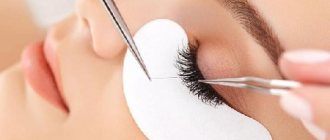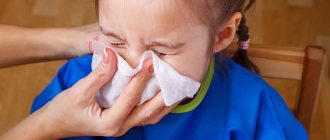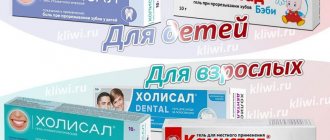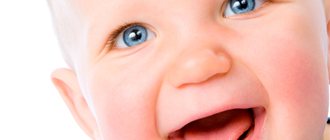30.11.2019
The appearance of the first teeth is an exciting event. In addition to the joy of teeth appearing, parents face new problems. One of them is how to help a child go through this period easily and painlessly. The appearance of the first teeth is often accompanied by certain manifestations. It is important to know about them as well as about drugs that can relieve their effects and help the baby.
Signs of teething in infants
How to understand that a little boy or girl is starting to teethe.
CAREFULLY! The symptoms of this process are similar to the development and course of acute respiratory viral infections (ARVI). It is important not to confuse the process of development of the masticatory apparatus with infectious diseases.
Common symptoms that indicate the imminent appearance of teeth include:
- increased body temperature;
- general malaise, weakness, lethargy;
- significant deterioration in appetite, refusal to eat;
- restlessness, irritability, restless sleep;
- manifestations of a runny nose are possible.
It is important to consider that if these signs persist for a long time, and there are no clear symptoms that may indicate the imminent appearance of teeth, then you need to call a doctor at home. Since in this case the problem is most likely not in the masticatory apparatus.
Local manifestations can provide more accurate data on the condition of the little man. These are the ones that will be visible on the gums and in the oral cavity, and will also be associated with these departments. Approximate time of manifestation is 4-5 months. These include:
- redness and slight increase in gum volume;
- changes in the functioning of the salivary glands, as a result, increased salivation;
- difficulty sucking, breast refusal may occur;
- the baby tries to “scratch” the gum with something and drags into his mouth any objects suitable for this (including his fingers, spoons, toys, etc.);
- Immediately at the end of this period of eruption, whitish tubercles of teeth appear on the surface of the gums.
First teeth
When do the first teeth start to emerge? The first teeth can appear at any time in babies from 3 to 15 months. This typically occurs between 4 and 9 months, although pain may occur earlier (excessive drooling at 3 months is usually the result of your baby putting things in his mouth, which is a sign of normal development). How can I help him?
- Gently massage your baby's sore gums with your fingertip;
- Let your baby chew on a teething ring - either a soft rubber one or a plastic one (keep the plastic ring in the refrigerator);
- If your baby is in pain, you can give him paracetamol in a dosage appropriate for his age;
- Avoid giving him toys with hard edges, which can damage his teeth and gums.
What not to do
- Do not lubricate pacifiers and teething rings with honey or sweet foods, as this can cause tooth decay (honey is generally not recommended for babies under 12 months);
- Do not lick the pacifier before giving it to your baby, as this will transfer bacteria from your mouth to his or her mouth.
Signs of teething
- Pink blush on the cheeks;
- Increased salivation;
- The baby pulls his ears;
- The baby chews everything;
- Inflamed gums;
- Increased excitability;
- Restless sleep;
- Poor appetite;
- Frequent loose stools;
- Pain and redness of the skin, or rash in the anus.
On a note:
Typically, teething does not cause fever. If your child has a high fever, call a doctor.
How to take care of your baby's teeth
Why are first teeth so important? Many parents do not understand that they need to take care of their baby’s first teeth just as carefully as they take care of their own teeth. In addition to the fact that baby teeth are necessary for the baby to properly eat food and develop speech, they also contribute to the normal development of the jaw bones and “reserve” space for permanent teeth that will appear later. Dental caries can lead to tooth loss in babies as young as 12 months. So-called “bottle caries” can be caused by leaving a baby with a bottle for a long time, from which he sucks milk or sweetened juice, during the day or before bed. If your baby requires a bottle before bed, give him cooled boiled water instead of formula or immediately after formula. Caring for baby teeth
- Start brushing your teeth as soon as they appear. Gently wipe your teeth with a damp cloth while bathing;
- Gradually move on to a baby brush with soft bristles and brush your teeth with plain water (there are special brushes for babies);
- Place your baby in front of you, facing the mirror, so that he can see you brushing his teeth;
- Let your baby play with his toothbrush while he watches you brush his teeth (it can take several years to teach your baby how to brush his teeth correctly!);
- When your baby learns to spit things out of his mouth, start using a low-fluoride baby toothpaste, squeezing literally one drop onto the brush;
- Limit the amount of sweet foods in your baby's diet.
How to help a child during this period?
The main factors that irritate and cause pain for infants are eliminated with the help of effective medications. In addition to them, folk remedies or “home” methods are used. This method is not recommended, but the possibility cannot be ruled out. After all, there are times when it is difficult to find a specialized medical center, but it is necessary to help the baby. These “homemade” types of helpers include solid foods (carrots, apples, dried fruit, etc.).
A good painkiller is regular cold. You can apply a cool spoon or cloth to the gum.
CAREFULLY! A common mistake parents make is giving their baby a regular ice cube. This should not be done! It can cause frostbite to the tissue and cause gum injury.
In cases where teething is very difficult (constant tears and crying, insomnia, etc.), it is impossible to do without medications. A pediatrician will help you decide which one to choose. Consultation with him in this matter is very important.
Panadol for teething
This is an effective drug that combats pain during teething in children. Available in two types: syrup and candles. The active substances include paracetamol, which works well in reducing fever and eliminating pain.
The advantage of this product is that its use is possible from the age of three months.
Only a doctor can tell you what form is best to use the drug. Several forms of medication are very convenient. Syrup can cause a gag reflex in some babies. In this case, there is no need to look for any other drugs, just use suppositories.
Panadol Baby syrup / Panadol baby
Available in a dark bottle of 100 ml. Recommended age of use: from 2 months to 12 years. The kit includes a dispenser in the form of a syringe, which greatly helps to control the dosage.
The suspension itself has a very viscous structure, reminiscent of jelly in appearance. It has a strawberry aroma and pinkish-red color. The taste is quite pleasant.
It is very important to remember that although the product looks like a tasty jelly, it is a medicinal drug, the abuse of which is highly not recommended.
The packaging states that if there are no therapeutic effects, you should stop taking it without increasing the dose and consult a pediatrician.
Panadol suppositories for children
Produced in the form of suppositories, this medicine is a good helper in the fight against pain and fever. These are whitish cone-shaped suppositories that do not have any strong odor. In normal condition, there are no defects or foreign impurities on their surface.
Packed in strips of 5 or 10 pieces. In total, one package contains from 5 to 20 candles.
Panadol Baby
An overdose of paracetamol can cause liver failure, which may lead to the need for a liver transplant or death. Acute pancreatitis was observed, accompanied by liver dysfunction and hepatotoxicity.
In the event of an overdose of Children's Panadol, even if the patient feels well and there are no significant symptoms of overdose, it is necessary to stop using the drug and immediately consult a doctor for medical assistance.
Symptoms and signs
The hepatotoxic effect in adults occurs when taking paracetamol in an amount of 10 g or more, in children - when taking more than 125 mg/kg of the child’s body weight. If there are factors that influence the toxicity of paracetamol to the liver (see sections “Interaction with other drugs”, “Special instructions”), liver damage may occur after taking paracetamol in an amount of 5 g or more.
With long-term use in excess of the recommended dose, hepatotoxic and nephrotoxic effects (renal colic, nonspecific bacteriuria, interstitial nephritis, papillary necrosis) may be observed.
During the first 24 hours after an overdose, the following symptoms may appear: nausea, vomiting, stomach pain, impaired glucose metabolism (sweating, dizziness, loss of consciousness), pale skin, decreased appetite, impaired carbohydrate metabolism. Clinical signs of liver damage usually develop after 24-18 hours and reach a maximum after 4-6 days. Signs of impaired glucose metabolism and metabolic acidosis may occur.
In severe cases of overdose, encephalopathy (impaired brain function), bleeding, hypoglycemia, cerebral edema, and even death may develop as a result of liver failure. It is also possible to develop acute renal failure with acute tubular necrosis, the characteristic signs of which are pain in the lumbar region, hematuria (admixture of blood or red blood cells in the urine), proteinuria (increased protein in the urine), while severe liver damage may be absent. There have been cases of heart rhythm disturbances and pancreatitis.
Treatment
If you suspect an overdose of Children's Panadol, even in the absence of pronounced first symptoms, you must stop using the drug and immediately consult a doctor for medical assistance. During the first hour after an overdose, it is recommended to take enterosorbents (activated carbon, polyphepane). The level of paracetamol in the blood plasma should be determined, but not earlier than 4 hours after an overdose (earlier results are unreliable).
There is no convincing evidence that gastric lavage beyond 60 minutes after overdose improves clinical outcome.
Administration of acetylcysteine within 24 hours after an overdose. The maximum protective effect is ensured during the first 8 hours after an overdose; over time, the effectiveness of the antidote drops sharply. If necessary, acetylcysteine is administered intravenously. In the absence of vomiting, methionine can be used before the patient is admitted to the hospital.
The need for additional therapeutic measures (use of methionine, intravenous administration of acetylcysteine) is determined depending on the concentration of paracetamol in the blood, as well as the time elapsed after its administration.
Treatment of patients with severe liver dysfunction 24 hours after taking paracetamol should be carried out in conjunction with specialists from a poison control center or specialized liver disease department.
Indications and contraindications
Like any medicine, Panadol for children has its own indications for use and vice versa. The remedy is in demand in the following situations:
- With a general increase in body temperature, which has developed due to an infection. These are flu, mumps, measles, intestinal infections and so on.
- When pain occurs. Acts as a good pain reliever. Effective for teething.
Reviews about this product on the Internet are mostly positive. The most important thing is to consult a doctor before use. Then the risk of developing any undesirable effects is minimized.
Panadol Baby Syrup
Instructions for medical use of the drug
Description of pharmacological action
Analgesic-antipyretic. Has an analgesic and antipyretic effect. Blocks cyclooxygenase in the central nervous system, affecting pain and thermoregulation centers. The anti-inflammatory effect is practically absent. It does not affect the state of the gastrointestinal mucosa and water-salt metabolism, since it does not affect the synthesis of prostaglandins in peripheral tissues.
Indications for use
Pain and fever syndromes (colds, flu, childhood infectious diseases, toothache, teething pain, ear pain with otitis, headache, sore throat).
Release form
syrup for children 120 mg / 5 ml; dark glass bottle (bottle) 100 ml with measuring syringe, box (box) 1; syrup for children 120 mg / 5 ml; bottle (bottle) of dark glass 300 ml with dosage spoon (spoon), box (box) 1; syrup for children 120 mg / 5 ml; bottle (bottle) of dark glass 100 ml with dosage spoon (spoon), box (box) 1; syrup for children 120 mg / 5 ml; dark glass bottle (bottle) 100 ml with measuring syringe, cardboard pack 1; syrup for children 120 mg / 5 ml; dark glass bottle (bottle) 300 ml with measuring syringe, cardboard pack 1; syrup for children 120 mg / 5 ml; bottle (bottle) of dark glass 1000 ml, box (box) 1; syrup for children 120 mg / 5 ml; dark glass bottle (bottle) 1000 ml; composition 1 rectal suppository - 125 mg; in polymer film 5 pcs. There are 2 films in a cardboard box.
Pharmacodynamics
It has analgesic and antipyretic properties, the latter manifesting itself in febrile syndrome of any origin.
Pharmacokinetics
Rapidly absorbed from the gastrointestinal tract. Plasma concentrations reach peak after 30-60 minutes; T1/2 plasma - 1-4 hours after taking therapeutic doses. Evenly distributed in the body. Metabolized in the liver to form paracetamol esters with glucuronic and sulfuric acids. 90-100% of the drug is excreted in the urine during the first day in the form of metabolites.
Use for renal impairment
The drug should be used with caution in case of impaired renal function. The drug is contraindicated in cases of severe renal impairment.
Other special occasions at reception
The drug should be used with caution in case of liver dysfunction (including Gilbert's syndrome). The drug is contraindicated in cases of severe liver dysfunction.
Contraindications for use
Severe liver or kidney dysfunction; — Newborn period; - Hypersensitivity to paracetamol or any other component of the drug. The drug should be used with caution in cases of liver dysfunction (including Gilbert's syndrome), renal dysfunction, genetic absence of the enzyme glucose-6-phosphate dehydrogenase, severe blood diseases (severe anemia, leukopenia, thrombocytopenia). The drug should not be taken simultaneously with other drugs that contain paracetamol.
Side effects
From the digestive system: sometimes - nausea, vomiting, pain in the stomach. Allergic reactions: sometimes - skin rash, itching, urticaria, Quincke's edema. From the hematopoietic system: rarely - anemia, thrombocytopenia, leukopenia. When taken in recommended doses, paracetamol rarely has side effects. If adverse reactions occur, you should immediately stop taking the drug and consult your doctor.
Directions for use and doses
Suppositories: rectally, children from 3 months to 3 years - 1 suppository. every 4-6 hours (but no more than 3 times a day).
Overdose
In the first 24 hours: pallor, nausea, vomiting, anorexia, pain in the abdominal area. After 12-48 hours: liver damage, metabolic disorders, metabolic acidosis. In severe poisoning, liver failure may progress (with the development of encephalopathy, coma and death). Acute renal failure with acute tubular necrosis can develop in isolation (in the absence of severe liver damage). Other disorders include cardiac arrhythmias and pancreatitis. Drug therapy: methionine orally or intravenously N-acetylcysteine (in the first 2 days after an overdose).
Interactions with other drugs
T1/2 is prolonged by barbiturates and tricyclic antidepressants. The effect is reduced by anticonvulsants.
Precautions for use
Cannot be used with other paracetamol-containing drugs. Prescribe with caution to children with impaired liver and kidney function. Before use in premature babies and children under 3 months (when taken for more than 3 days in a row), you should consult a doctor for advice.
Special instructions for use
Clinical (laboratory) manifestations of hepatotoxicity can be observed in a delayed period (up to 1 week).
Storage conditions
List B.: In a place protected from light, at a temperature not exceeding 30 ° C (Do not freeze).
Best before date
36 months
ATX classification:
N Nervous system
N02 Analgesics
N02B Analgesics and antipyretics
N02BE Anilides
N02BE01 Paracetamol
Analogs
As for rectal suppositories, during teething you can also use cefekon or viburkol. This dosage form is very convenient for use in young children. The active substance in cefekon is paracetamol. Viburkol has a lot of them, these are mainly herbs (belladonna, chamomile, etc.)
A good remedy for pain during teething is Cholisal gel. This drug contains choline salicylate and cetalkonium chloride. They have pronounced analgesic and anti-inflammatory properties, but have their own nuances and contraindications for use, which should be clarified with a doctor.
Category Children, Medicines / drugs Published by Mister stomatolog










